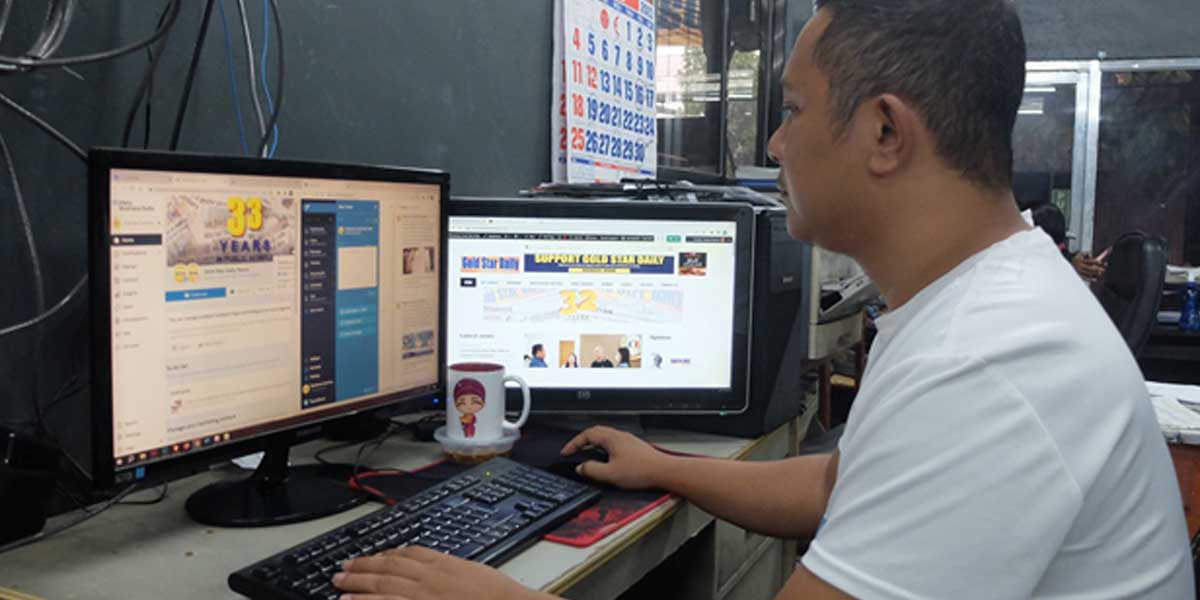

By Cong Corrales and Francis Allan Angelo
(This story was republished with permission from Rappler)
Part 2: Part 2: ‘The democratic aspirations of the republic will never come to fruition if its people continue to refuse to practice it,’ journalist Froilan Gallardo says
The year 2016 could very well be the annus horribilis for community journalism. Suddenly legacy news media outlets became “presstitutes” on social media – thanks to the advent of troll farms of various political camps.
Community journalists were hardest hit by the cyberattacks owing to the more intimate nature and proximity of the people they cover compared to the reportage in metropolitan centers in the country.
It was during this same year that there was a spike in the number of online attacks, harassment, and cyberattacks against community journalists and legacy news media outlets. These online attacks were mainly aimed at silencing reportage on the killings under the pretext of the war on drugs by then-president Rodrigo Duterte.
A study by the Freedom for Media, Freedom for All Network, released on November 23, 2018, documented at least 99 cases of “acute and creeping online and offline attacks against news media organizations and journalists” in the first 28 months of Duterte’s presidency, or from July 1, 2016, to October 31, 2018.
That is roughly four journalists attacked online and offline per day.
The Center for Media Freedom and Responsibility, the National Union of Journalists of the Philippines, the Philippine Press Institute, MindaNews, and the Philippine Center of Investigative Journalism comprise the network.
Red-tagging
In Cagayan de Oro City, online attacks on various social media platforms have taken a more specific tact: red-tagging.
In March 2020, Cagayan de Oro City-based veteran journalist Froilan Gallardo was red-tagged when he showed solidarity with the television network ABS-CBN on the possible cancellation of its legislative franchise.
Along with other reporters, Gallardo was attending a rally in support of ABS-CBN at the TV network’s regional office in Barangay Bulua when a courier delivered copies of bond paper-sized posters that accused him of being a member of the revolutionary movement.
The material also targeted the late Nonoy Espina, and his sister Inday Espina-Varona (now Rappler head of Regions), Renwynx “Don” Morgado, a staff member at the Misamis Oriental capitol’s information office, and Loi Algarme, a reporter at Radyo Natin.
“Speaking truth to power is not a crime. I’m getting tired of this red-tagging. I say bring it on,” Gallardo said.
Gallardo pointed out that starting in 2016, partisan bloggers and influencers have drowned out legacy media outlets. He said the partisan influencers had flipped the narratives on almost all of the critical issues affecting Philippine provinces.
The algorithm employed by social media platforms, he added, could also be partly to blame. Gallardo said that social media started out as a platform where we could have an exchange of ideas. But when the trolls of partisan political camps took over, a lot of people were effectively misled.
When former journalist Pam Orias was red-tagged in 2019, she said her parents wept and asked her to leave her job at the now-defunct SunStar Cagayan de Oro Daily (Sunstar-CDO).
“It’s really difficult to reconcile with the concerns of your family and your desire to write,” Orias told MindaNews in an August 7, 2019 news article.
Bandwagon, pressure
While they appreciate the benefits of social media presence in terms of growing their audience and marketing, Iloilo journalists also acknowledge the downside of the current trend.
May Ortega, news director of Aksyon Radyo-Iloilo, said interaction between a news organization and the audience used to be a one-way setup, but social media “democratized” not just the exchange of opinions but bashing as well.
“The downside of our situation is that everybody can now chime in on just about anything. But it also exposes journalists to attacks and unfair comments that tend to undermine our work. The bandwagon effect is an effective way for our detractors to gang up on us. One nasty comment against us could trigger a flood of reactions from similar minded netizens. Such is what happened to cases of red-tagging of journalists – one false accusation ballooned to the wholesale vilification of our colleagues,” she added.
Panay News editor Glenda Tayona agreed with Ortega’s observations on online attacks against journalists, particularly red-tagging, online bashing, and gaslighting.
“Apart from the pressure of looking for and creating content, the more concerning aspect are attacks on our colleagues in the community. It’s stressful to read nasty comments on our reports but what is more painful are the gaslighting statements that could lead to bodily injury to journalists,” Tayona said.
Apart from online bashing, attacks against journalists have become more sophisticated, like what happened to several news organizations that were part of Facts First PH.
For one, lawfare or the use of laws to intimidate news organizations has become a norm in the Philippines.
The 2022 Digital News Report of Reuters described how a former presidential communications official threatened that “the government’s anticommunist task force intended to take legal action against Rappler for allegedly spreading disinformation, as well as against Facebook for allowing Rappler and Vera Files ‘to abuse the immense powers’ of their designation as the platform’s third-party fact-checkers.”
Cyberattacks on news organizations and fact-checkers also became widespread, particularly in the lead up to the 2022 elections.

“Big and small news organisations were targets of what seemed to be coordinated distributed denial-of-service (DDoS) attacks that crippled their websites for hours, even days. Apart from Rappler and Vera Files, ABS-CBN, GMA News, CNN Philippines, Interaksyon, PressOnePH, and Mindanao Gold Star Daily were attacked; so were alternative news sites Bulatlat and Pinoy Media Center. Months earlier, the attacks against Bulatlat and another alternative site were traced to an IP address assigned to the Philippine Army. The country’s ranking in the World Press Freedom Index slipped further, by nine spots to 147th out of 180 countries,” the 2022 DNR described the Philippine situation.
Daily Guardian, which is also part of Facts First PH, also suffered DDoS attacks weeks before Filipinos went to the polling centers in May 2022. For three days, its website was inaccessible due to unusually heavy traffic to the site.
Infodemic
At the height of the pandemic, Cagayan de Oro wasn’t exempt from the deluge of disinformation, from so-called alternative cure against the COVID-19 virus to fake announcements of quarantines.
Community journalists were in a quandary as to where best to source information about the pandemic because most people in government, including the Department of Health-10, were also in the dark and appeared disorganized in disseminating information.
Online trolls, of course, jumped into the chaos.
These fake news articles on the pandemic flooded local Facebook pages. Many of the community journalists had petty arguments with their family members.
“I even have arguments with my mother because she believes in almost anything she reads on Facebook,” said Gallardo.
Exacerbating this anxiety-inducing events on social media, community journalists were also unsure of their job security because many legacy news outlets, especially print medium, shut down. Freelance reporters and contractual media workers bore the brunt financially, especially those who lost their jobs due to closures as their media outlets declared bankruptcy.
Long-time sports reporter Lynde Salgados was so depressed when his outlet SunStar Cagayan de Oro Daily declared bankruptcy on June 30, 2020, that he stopped writing altogether for at least two years.
“This is the only craft I love and am good at. How am I going to feed my family after this?” Salgados said.
Salgados’ editor-in-chief Pamela Orias dreaded the thought of their news outlet shutting down.
“I have no other job options,” Orias said in a Gold Star Daily article. After 25 years, Sunstar-CDO decided to stop running the presses.

Pushing back
Amid the challenges they are facing, community journalists in the Visayas and Mindanao have banded together to reclaim their place on social media platforms.
Most news houses in the provinces are taking the cudgels in fighting for their place in the digital platforms.
Gallardo said it is high time for journalists to push back against disinformation and the attacks.
“The democratic aspirations of the republic will never come to fruition if its people continue to refuse to practice it,” Gallardo said.
Former journalist Joseph Ben Deveza, who now teaches a communication subject in Xavier University’s Development Communication under its College of Agriculture, said the problem started when the legacy news media failed to nip in the bud the fake news the so-called influencers and trolls spread on various social media platforms.
“It is understandable why we were caught flat-footed. Most, if not all, of the handlers of these trolls and influencers used to be our colleagues,” Deveza said.
He said these former community journalists who have “sold their skill sets to the highest bidder” should not only be made to account, but also be called out at every outset in their disinformation attempts.
For his part, Gallardo said community journalists should get back their bearings as the source of vetted and corroborated information in any medium.
“Even if there are new platforms, journalism has not changed. I refuse to believe that the discipline of every newsroom across the country can be defeated by these grammar and truth-challenged influencers,” he said.
“Community journalists must be at the forefront in the fight against disinformation,” Gallardo added. – Rappler.com
Cong Corrales and Francis Allan Angelo are Aries Rufo Journalism fellows.
Part 1: Social media: A multiple-edged sword for community journalists